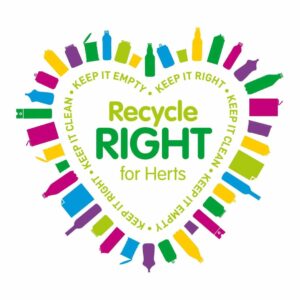 The St Albans Soroptimists’ “Love Food, Hate Waste?” event for #SUSTFEST22 gave everyone “food for thought” and lots of actions to takeaway!
The St Albans Soroptimists’ “Love Food, Hate Waste?” event for #SUSTFEST22 gave everyone “food for thought” and lots of actions to takeaway! 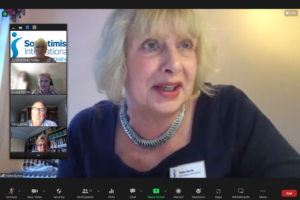 (pictured below) St Albans’ Recycling and Waste Officer. The meeting was chaired by Helen Byrne, Soroptimist Planet Team facilitator and co-President (see pic).
(pictured below) St Albans’ Recycling and Waste Officer. The meeting was chaired by Helen Byrne, Soroptimist Planet Team facilitator and co-President (see pic).David introduced his talk: how much waste is there? how much of that is food? how good are we at recycling food waste? should we be looking at reduction and not just recycling? How might we do this?
How much waste is there? During the last 10 years there has been a gradual reduction of household waste, until COVID 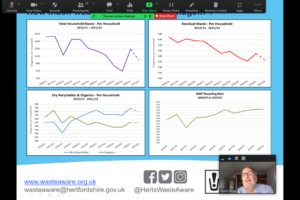 and the first lockdown. It’s likely that this was due to people to working from home and waste that would have gone into commercial recycling was redirected to household waste.
and the first lockdown. It’s likely that this was due to people to working from home and waste that would have gone into commercial recycling was redirected to household waste.
David explained that residual waste is the name used for waste that just goes into bins and therefore landfill. Residual waste has also continued to decline after a small spike during lockdown.
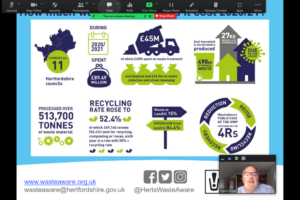 How much waste and what did it cost 2020/21? The average household was about half a ton per household, about 5% up on what would have been expected if lockdown hadn’t happened.
How much waste and what did it cost 2020/21? The average household was about half a ton per household, about 5% up on what would have been expected if lockdown hadn’t happened.
How much food waste is there? Nationally (last estimates from 2017) over 5 million tons of food waste is produced per year. This made up nearly one fifth of all household waste. Plastics, although large in volume, is relatively light in weight so doesn’t account for that much of the waste.
How good are we at recycling food waste? Herts residents typically use lockable curb side bins collected by recycling collection vehicles. Any flats not currently getting recycling collection will be included in the next year or two due to a government agenda.
How is recycling processed in Hertfordshire? There are two Anaerobic digestion (AD) plants – one near St Albans and one in Hoddesdon. Food is broken down without the presence of oxygen and the heat produced is collected as renewable energy.
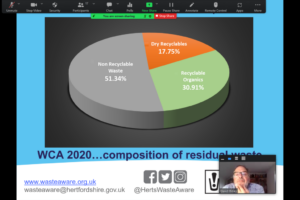 How effective has the food waste collection been? Other specialist research organisations process this information to report back as a waste composition analysis report. They sift through random representative samples of waste collected in the bins. This last happened in late 2020. There are 7 food recycling schemes now in existence in Herts, only 5 existed at the time of the report. They estimated that our 60% of food waste captured for recycling topped the leader board. Other authorities were between 30 – 50%.
How effective has the food waste collection been? Other specialist research organisations process this information to report back as a waste composition analysis report. They sift through random representative samples of waste collected in the bins. This last happened in late 2020. There are 7 food recycling schemes now in existence in Herts, only 5 existed at the time of the report. They estimated that our 60% of food waste captured for recycling topped the leader board. Other authorities were between 30 – 50%.
There was a dry recycling comparison for the 5 year period between 2015 and 2020 which showed an improvement in all areas. Food waste wasn’t being collected until relatively recently so the isn’t comparison data available.
In a typical residual bin’s content, over 40% is recyclable, 30% of that was food waste that wasn’t being captured by the recycling schemes.
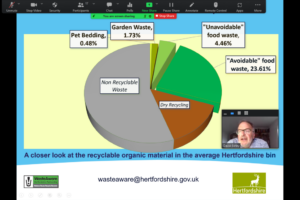 Food waste analysis – 80% of food waste was avoidable food waste, food that was edible at the time of purchase. Examples included over-ordered takeaway, mouldy bread/cheese, etc. Food waste accounts for 5 million pounds of the 9.5million recycling costs.
Food waste analysis – 80% of food waste was avoidable food waste, food that was edible at the time of purchase. Examples included over-ordered takeaway, mouldy bread/cheese, etc. Food waste accounts for 5 million pounds of the 9.5million recycling costs.
Waste – How can we reduce it? Nearly 1/4 of rubbish is avoidable food waste. There was a 2022 Survey of residents about their food buying, storing and wasting habits, with a high response rate from the public in Hertfordshire (3000).
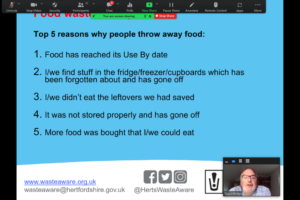 Top reasons: reached used by date, been overlooked/forgotten, didn’t eat leftovers saved, poorly stored and gone off, more food bought than could be eaten.
Top reasons: reached used by date, been overlooked/forgotten, didn’t eat leftovers saved, poorly stored and gone off, more food bought than could be eaten.
Waste Aware ran focus groups and three issues were identified to be addressed:
- Awareness – not aware of link between food waste and climate change.
- Skills – gap in skills on storage techniques, cooking skills, freezing/defrosting
- Lifestyle – busy lifestyle, cooking and storage facilities, catering for different tastes, allergies and dietary requirements
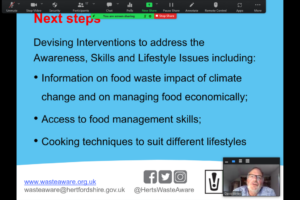 Next steps: Waste Aware Herts is turning results into a programme which will be trialed in the Three Rivers Council area. Then there will be evaluation of the programme and more analysis exercises. Waste Aware will then pick programmes that can be rolled out across the county.
Next steps: Waste Aware Herts is turning results into a programme which will be trialed in the Three Rivers Council area. Then there will be evaluation of the programme and more analysis exercises. Waste Aware will then pick programmes that can be rolled out across the county.
Louise Palmer (pictured) talked about St Albans Council 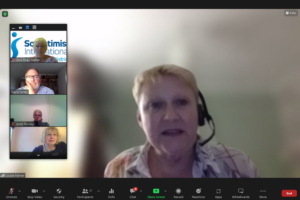 recycling. She was able to update us on initiatives in St Albans. St Albans provides recycling bins for 95% of flats.
recycling. She was able to update us on initiatives in St Albans. St Albans provides recycling bins for 95% of flats.
Wasting food feeds climate change so its vital we find ways to reduce it.
To save food waste it was suggested that people visit the websites www.lovefoodhatewaste.com and www.ingredientpairings.com
Shops that help reduce waste are The Refill Pantry at Carpenter’s Nursery in Sandridge and in Berkhamsted www.therefillpantry.co.uk and The Green Stores in Croxley Green thegreenstores.co.uk
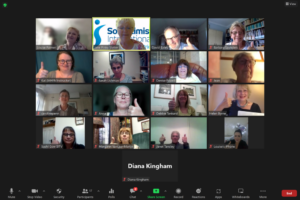 There wasn’t time for all the questions from attendees to be put to the speakers so they will be followed up by the Club’s Planet Team separately.
There wasn’t time for all the questions from attendees to be put to the speakers so they will be followed up by the Club’s Planet Team separately.
David and Louise were thanked for joining us (with thumbs up from everyone – see pic) – they certainly gave us all “food for thought” and lots of actions to takeaway!
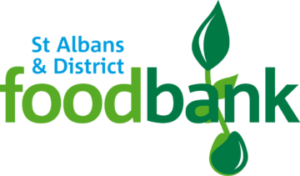 Donations for the St Albans Foodbank from the event came to £75. The foodbank provides emergency food and support to local people in crisis. You can click here to donate via Paypal www.sigbi.org/st-albans/donate or you can email sistalbans@hotmail.com and ask for the bank details to do a transfer.
Donations for the St Albans Foodbank from the event came to £75. The foodbank provides emergency food and support to local people in crisis. You can click here to donate via Paypal www.sigbi.org/st-albans/donate or you can email sistalbans@hotmail.com and ask for the bank details to do a transfer.


